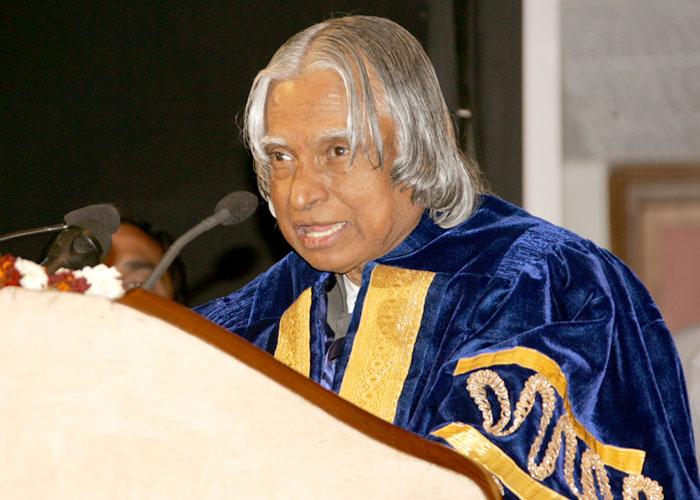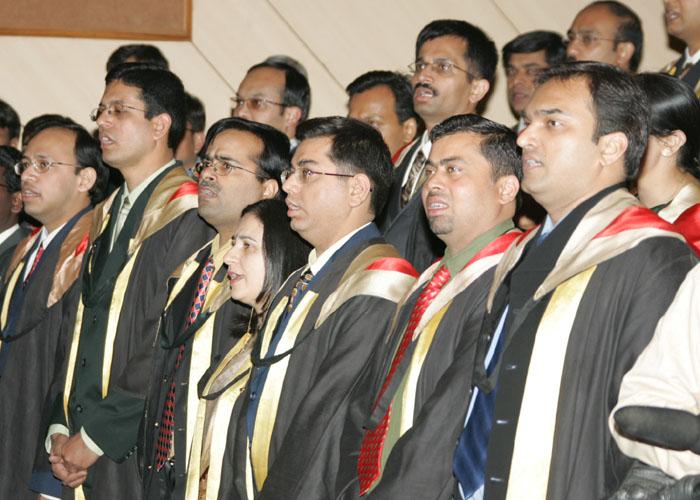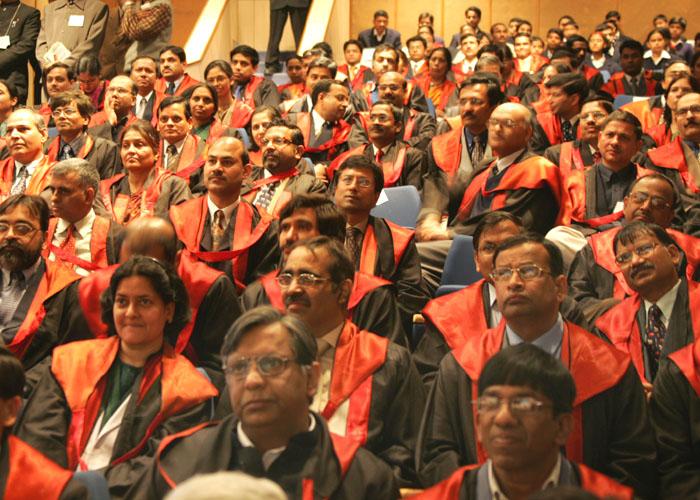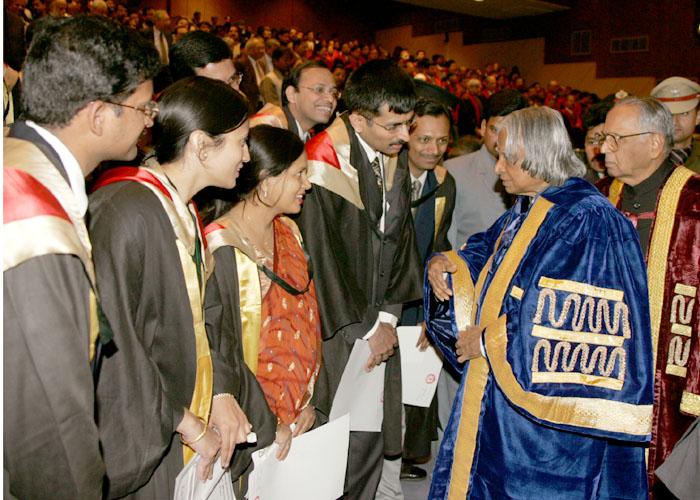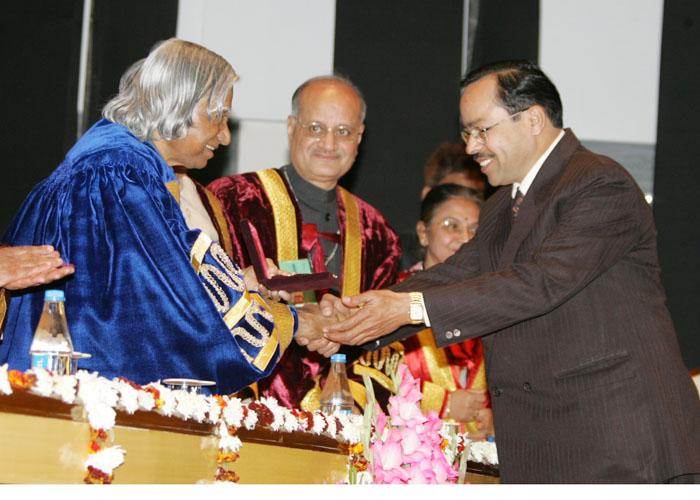Address At The Convocation Of Sanjay Gandhi Postgraduate Institute Of Medical Sciences, Lucknow
Uttar Pradesh : 14-01-2005
Healthcare through Fusion of Multiple Technologies
I am indeed delighted to participate in the Convocation 2005 of Sanjay Gandhi Postgraduate Institute of Medical Sciences. I greet the Director, professors, Faculty Members, doctors and staff for their contribution in shaping young doctors as super specialists in different fields of medicine. I take this opportunity to congratulate the student doctors of this Institute for their academic performance. This Institute has a major responsibility of enriching the students with state-of-the-art medical science and promotion and participation of students in societal missions. I am happy to note that this Institute has a tele-class room that has been connected to number of advanced centres of medical education. I was thinking what thoughts I can share with this enlightened members of this beautiful Institute. I have selected the topic for discussion ?Healthcare through Fusion of Multiple Technologies?
Supremacy of the human mind
Since you are all going to work with the integrated system of psychology and physiology of human beings, I would like to share with you, friends, some of the predictions of Ray Kurzweil written in his book "When Computers Exceed Human Intelligence - The Age of Spiritual Machines". World Wide Web will make tremendous impact in the way we communicate and live. Most of the computers and accessories will be of micro sized, wearable and will have wireless communications with each other. Moderately priced PCs capable of performing about billion calculations per second today will be able to perform about trillion calculations per second within next 10 years. And by 2020 computational ability of an ordinary PC will exceed the capability of human brain. By 2030 the capability of a normal PC would be around 1000 times of human capability.
By the end of this century there would be a strong trend towards merger of human thinking with the world of machine intelligence that the human species initially created. When there would no longer be any clear distinction between human and computers, how are we going to retain the supremacy of man over machines? Computers are going to give us a challenge. It is not only for the biologists and bio-technologists; the entire scientific community would have greater responsibility of keeping the mankind above the man-made computers. Fortunately, the creativity and imagination components of human beings are supreme, and will continue to excel which need to be explored and utilized. The human genome is full of software that is yet to be activated to unleash the ingenious potentials of human species.
Time has come for the medical community to work towards enhancing our abilities in the field of bio-science, bio-informatics, bio-technology and nano-technology and their convergence for providing cost effective medicare to the entire mankind especially those living in far flung rural areas. Now I would like to discuss with you a case study of my friend who is now walking with a British Liver. It is essential that India has high reliability centres for successful liver transplant.
Walking with a British Liver (Case Study)
Early Symptom: Since 1995, my friend had an upset stomach and mild fever. He ignored and relegated it to something associated with frequent traveling, meetings beyond regular office hours, taking food at odd hours. He consulted many physicians at the instance of his family members and they also gave the same opinion. They diagnosed it as related to water and food changes and he had an amoebiasis problem and prescribed medication like Tiniba-500. This used to bring relief for a month or two and the problem again reappeared. Since he was an intensive scientific worker, he ignored the low grade fever which persisted for many months. He lost 11kg of weight in four months time and his blood profile indicated that the sugar level was in the upper limit. At around this time his face also started turning a darker shape. He attributed the change to age and epidermis damage and the frequent exposure to UV rays in the hot desert during field trials.
First Investigation: At the instance of his friends and family members he underwent a thorough pathological testing at the King Edwards Memorial (KEM) Hospital in Pune in May of 1999. All possible tests under the sun were conducted ? liver functioning test (LFT), ECG, Barium meal test, and ultrasonic exam of stomach, endoscopy and X-rays. To his utter delight, all the test results turned out to be normal with no major abnormalities. The only noticeable change was the increased bilirubin level, which was 1.2 against a normal value of less than 1. Liv-52 tablets were suggested for a few months. However there was no noticeable change in his physical condition.
Recurrence in 1999: Later in 1999 my friend got an infection while he attended a Conference in Russia which led to severe loose motion and high fever. With great difficulty he got back home after four days and was confined to bed for a whole week. A month later he had severe stomach convulsion, a nagging pain and swollen lower limbs. He felt and looked very week and sought the opinion of a leading liver expert at Hyderabad. All the tests for different types of Hepatitis were conducted and the test results turned out to be negative. Though the liver was found to be of normal shape and size the symptoms were definitely that of liver disease and he was prescribed a few medicines. He took the medicines for a month but there was no improvement.
Alternative Treatment: Finding no improvement in Allopathy he turned to Ayurveda. He started taking the concoction of lentil and rice and bitter herbal medicines and in this process his condition deteriorated further and he started having in addition to mild fever tender and swollen stomach and lower extremities. He could neither eat nor sleep or sit at ease.
Acute Condition: In October 1999 he got his ?bilirubin? checked at INMAS which was alarmingly high at six. He consulted Dr. Sardesai at Pune who diagnosed his condition as acute liver problem and prescribed medicines to tone up the liver functioning and avoid infection. He advised fruit juices, frequent small meals and thirty minutes rest after lunch. And also he advised to avoid all strenuous routines. This treatment worked well for a month and the symptoms resurfaced again.
In view of the recurrence my friend met Prof Acharya of All India Institute of Medical Sciences, Delhi on 7th December 1999. After examining his tender and swollen stomach declared that my friend has a severely damaged liver and advised him to get admitted immediately.
He was put through a series of tests and all liver function test results turned out to be alarmingly high. His endoscopy indicated that he had varices. His RBC count was very low and WBC was high. He was being injected plasma medications periodically and he had to undergo fluid removal from his stomach. It was clear that he had cirrhosis of liver but what perplexed them was the source of the infection since it did not fall in the category of the patients with a known history of possible infection routines. After consultation with many specialist doctors they surmised it to be Hepatitis C with anti-immune problem. Dr. Acharya explained that strangely the body defence system of my friend itself has started attacking one of his body organs and in this case it was liver.
Decision for Liver Transplant: Hepatitis C is the heterogeneous infection. Its interrelationship with human immune system is variable and difficult to co-relate. However, some trends have been identified. In some patients serious liver disease may occur within the first few years. However, in most patients chronic liver disease requires infection for 20 to 30 years. The most common presentation of Hepatitis C is a patient with no complaints. It is reported that 85% patients infected with HCV will develop chronic inflammation of the liver and of these 20% will develop cirrhosis of the liver. When my friend?s condition stabilized, he was discharged from AIIMS in February 2000. His joy of returning home was short lived and he returned to AIIMS with an infection in March 2000. At this time he went into Coma periodically and his kidney also started failing. This resulted in Prof Acharya pronouncing the inevitable that liver transplant as the only solution for saving my friend. Of the many medical centres all over the world where liver transplants are routinely carried out Prof Acharya recommended at that time (year 2000) Saint James Hospital at Leeds UK.
Long wait and Treatment in UK: At Saint James Hospital he was explained of all the pros and cons of the surgery and registered for a compatible liver. He was kept in the waiting list. There was a long waiting list for the reasons of national policy that UK citizens will be given highest priority. During this period he met many fellow survivors who appeared to be very formidable people who had handcrafted their own techniques of surviving. One day they were full of hope and the next moment they wondered how long they can holdup. My friend took solace in Yoga. He rediscovered the joy of being a family person. After one month of stay my friend got a call from the hospital that they found a donor. Finally my friend was operated on the 13th of June 2000 by Dr. Peter Lodge and his gifted team of doctors, one of whom Prof Merwin Davies who happened to be the close friend of Prof Acharya. The operation took seven hours. Later he regained consciousness and saw the people around him who were in smiles after the successful operation.
Post Operative Care: The disease, anxiety and surgery took its toll on the appetite and physical strength of my friend. He was forced to eat and drink more to make up for the loss of muscles and weight. He was surviving on three and four bottles of ?Enlives? per day. Finally he left the hospital after seventeen days and weighed only 57 kg when he was wheeled out. He was slowly permitted to eat everything except Grape fruit. He was also prescribed many drugs including immuno suppressants, anti-biotics, anti-fungals and anti-depressants. As usual all these medicines caused their own side effects. He remained in Leeds for over three months under the care of expert doctors after the operation and flew back to India with his family. After coming back to India he is permanently on medication involving an expenditure of over Rs. 15,000 per month during the first year and Rs. 5,000 per month in subsequent years continuously which is definitely much beyond the reach of a common man.
I am telling this experience of my friend to the medical experts assembled here so that they can address the problem of diagnosing this type of liver disease in the early stage so that it does not become an agonizing experience for the patients and the family. Also, the medical community must carry out intensive research and find low cost medicines for post operative life long care of liver transplant patients. All the more it is important, the specialized hospitals which deals with liver transplant, they must aim at least more than 95% success rate. Now I would like to share my thoughts on Biotechnology in Healthcare.
Biotechnology in Health Care
I would like to share my experiences while I was in Anna University, Chennai. A unique research effort resulted in getting a patent for a new molecule discovered from an herb as an anti cancer drug. This came out of the fusion of two great minds, one was a bio technologist and the other was a traditional siddha medical practitioner. The traditional system of medicine like Ayurveda, Siddha etc have advocated and practiced preventive and curative medicinal recipes specific to individuals. The body, mind, food and environment were looked at holistically to suggest a preventive or curative approach to health. New technologies such as human genome sequencing, proteomics, pharmaco-genomics, ultra high throughput screening are revolutionizing drug discovery. Medicinal plants offer enormous scope for development of drugs. We need to create database of traditional medicinal plants for specific bioactivity and lead for development of new drugs. India has got tremendous potentials for herbal farming and research which can definitely enable us to produce cost-effective drugs. Medical community have a great responsibility in carrying out clinical trials and providing data base to the pharmaceutical companies for introducing the drugs well before the shelf life of the drug expires. The next area I would like to take up Stem Cell Research and Gene therapy.
Gene Therapy
The interfacing between medical science and various other technologies such as biotechnology, has given rise to techniques both curative and investigative and has provided the research worker with number of tools to pry into the working of various physiological functions right up to the molecular levels. Developments in bio-technology and molecular biology have now made it possible not only to design the drugs for specific properties but also to deliver them to the specific sites where they are most required. The onset of nano technology has further enhanced the capability of drug delivery system to reach the disease spot with precision.
Newer imaging techniques have now made it possible to obtain real time images of the various organs at a physiological and biological level and hence the right treatment is administered. Medical research will lead to identification of not only the genes that cause disease but also correct the defects through gene therapy.
Possible Solution for cardiovascular disease
The occurrence of cardiovascular disease is increasing rapidly, particularly in the Indian community. Multi-dimensional solutions are available for management of the disease based on my discussion with experts. The solutions include medicinal treatment using Statins, which lowers the cholesterol in the blood by reducing the production of cholesterol by the liver. Statins block the enzyme in the liver responsible for making excess cholesterol. However one has to be careful about the side effects and take adequate precautions while treating the patients. The second is through angiography and angioplasty using stents. If the heart blockage is severe, valve defect and death of cells in the heart due to less blood supply etc., surgical intervention will be necessary. What are the future promises for treating the hearts?
(a) Stem cell therapy for future heart ailments
Newer knowledge emerging out of research on stem cells from abroad and India has to be taken note of and studied. Drawing of tens of thousands of stem cell - immature cells that are capable of transforming themselves into almost any kind of tissues from the suffering patients and inject them into the heart to stimulate heart repair. In one case, it is reported that the pumping efficiency has increased from 25% to 40% over a period of four months. In 2004, successful stem cell procedures that resulted in measurable boost in blood pumping capacity have increased substantially in many countries across the globe. This holds a big promise for effective heart repair for ailing people.
(b) Experience in stem cell: During my visit to various laboratories, I happened to see the beginning of stem cell research for different purposes including brain research. I would like to share with you an important stem cell research application in the field of cardiology. When I met Dr. P. Venugopal, Director, All India Institute of Medical Sciences (AIIMS) a famous cardiovascular and thoracic surgeon, he told me about his experiences. He said in one of the cardiac diseases, where conventional medical and surgical treatment were ineffective because of the affliction of the heart muscle, use of autologous bone marrow stem cells implantation into the diseased heart muscles had been applied in order to improve the function of heart muscle. This kind of application of this procedure is the latest and very few cases have been done in the world, the first time in India. This is expected to open new frontiers in the treatment of patients for regeneration of heart muscles, thereby giving new hope for the patients suffering from end stage heart disease.
The New Scientist (dated 25th September) has reported another remarkable recovery of a heart patient at the John Wolfgang Goethe University at Frankfurt. Of course for the first time, I have come across a warning, stating that risk is very high. Against stem cell solution for every aspect of human disease, it is reported that large amount of tests on animals is needed before applying it on humans.
Stem Cell for Restoration of Vision
The recent identification and characterization of progenitors with stem cell properties has opened new avenues that may be useful for treating functional impairments caused by the death of specific cell population. Stromal and neuronal degeneration are the causes of debilitating visual impairment associated with many ocular diseases, such as degenerative diseases of cornea, retinitis pigmentosa (RP), age- related macular degeneration (AMD) and glaucoma. The stem cells may help restore vision in patient who has these diseases, by repopulating or rescuing the damaged ocular surface cells or retinal cells from further degeneration.
The stem cell team of LV Prasad Eye Institute has administered stem cells in the affected region of the eye for over 200 patients and all of them are performing very well. Apart from India these patients have come from Bangladesh and Nepal. The research in these frontier areas are facilitated by quality research publications.
Stem Cell research ? focus
On 4th January 2005 during the Indian Science Congress, I had a discussion with the researchers and clinical physicians who are working in Stem cell area. They are working in different areas of stem cell, such as Cancer treatment, ophthalmology, spinal cord, cardiology. Details of some of the success stories and experience were shared.
Dr. Bhan, Secretary, DBT and Dr. Ganguly, DG-ICMR are working together in promoting stem cell research. They are evolving a road map for stem cell research through three areas such as Adult stem cells, umbilical cord stem cells, and embryonic stem cells. A focus has been given to stem cell research so that a mission mode operation can soon commence. I was happy to note that the clinicians are driving the research; this will enable easy technology transfer and fast diffusion of technology. I would suggest the members of Sanjay Gandhi Postgraduate Institute of Medical Sciences can participate in the National Stem Cell Research and Application programme.
Research for treatment of Parkinson?s disease
Recently I met Prof. Vijay K Varadan of Pennsylvania State University, US. He shared his experience on the possible line of treatment for Parkinson?s disease and Epilepsy. The primary symptoms in Parkinson?s Disease as you all aware are tremor or trembling in hands, arms, legs, jaw, and face, rigidity or stiffness of the limbs, slowness of movement and impaired balance. Prof Varadan has devised a wireless system for monitoring and control of Parkinson?s disease. The system consists of an implantable DNA insert in the head region for generating a pulse to the nerve system; controlled either by a modified pacemaker or smart hat having passive polymer based gyro sensors, which are implanted in the tremor location. The sensor gets the power from the Pacemaker and the Pacemaker then reads the tremor motion. The Pacemaker then generates the pulse in the implanted device in the head to control the tremor. This appears to be a promising line of treatment for such diseases. Prof. Varadan also has reported that a few patients affected by Parkinson?s disease had full recovery. Can the medical community explore the possibility of using a combination of stem cell and gene chips as a line of treatment for Parkinson?s disease or epilepsy.
Conclusion
Whether India has to eradicate leprosy or TB, to prevent spread of HIV by developing anti HIV vaccine, or to control cardio vascular diseases by multiple technologies and practices, we in India need something important apart from resources. That is creative leadership in all fields, particularly in medical field. Who are the creative leaders? What are the qualities of a creative leader? The creative leadership is exercising the task to change the traditional role from commander to coach, from manager to mentor, from director to delegator and from one who demands respect to one who facilitates self respect. The higher the proportion of creative leaders in the medical field, the higher the potential for successes in medical field in diagnosis, treatment and research for discovering new avenues in healthcare.
My congratulations to all the post-graduates and my best wishes to the medical community in their mission of making a disease free India.

